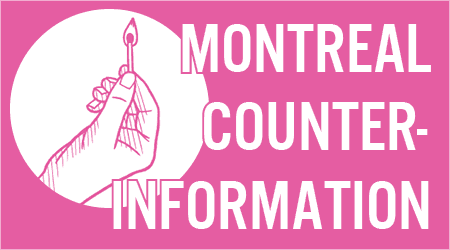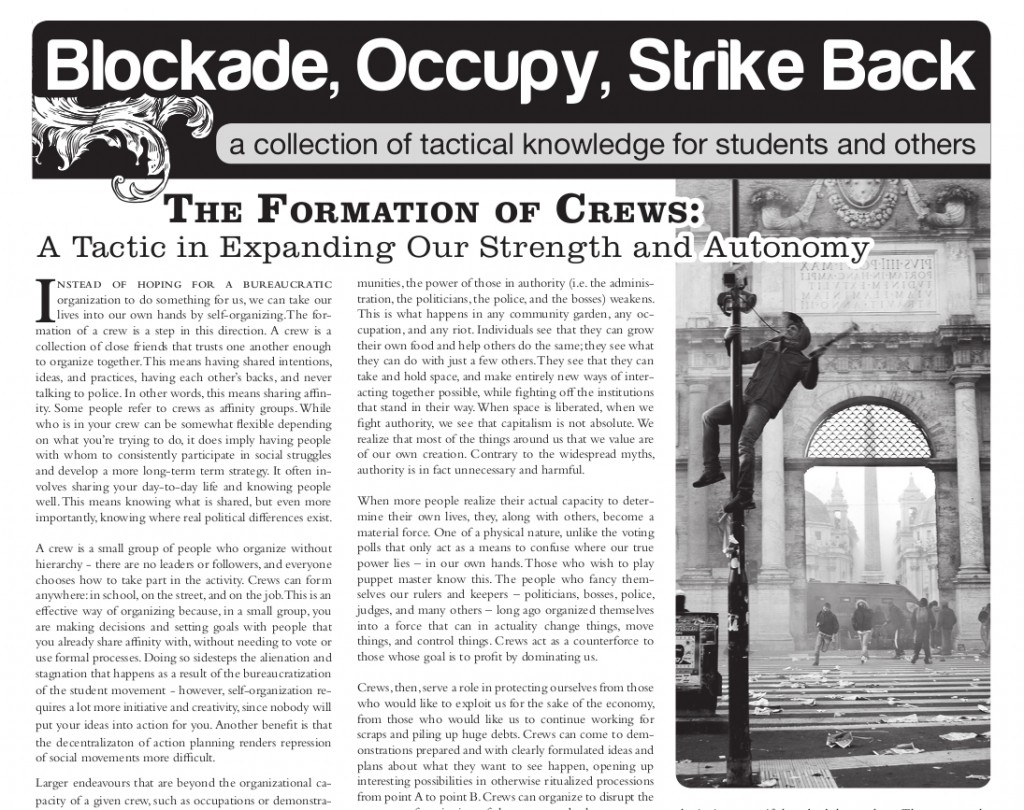From Blockade, Occupy, Strike Back
While people can participate in demos with their crew, sometimes it makes sense for crews to act together in a contingent or a bloc. The form chosen should fit the context. Here is a collection of tips for acting within demos – some are applicable more broadly, others are more specific to a bloc.
The way a demo moves can determine its outcome. While there are situations where moving quickly can be strategic, running blindly in a panic is the worst thing people can do. The police often attempt to disperse rowdy demos, and being able to hold our ground, not panic, and fight back is crucial.
A snake march—weaving up and down different streets and changing direction often and unpredictably (but strategically) – is a good way for spontaneous demos to evade police. Marching against traffic on one-way streets makes it difficult for the police to control the march.
It is important to pay attention to what’s happening around you. Stay aware of your surroundings. Notice any police lines that are being reinforced. Kettling is another tactic police use in mass arrests wherein they try to surround a demo from all sides, either in a street between intersections, or inside an intersection. This is why, if the demo is large enough, it should always try to hold two intersections at a time to leave an alternate route open.
Structures for quick communication need to be developed. People can spread messages and plans quickly by going from crew to crew.
Never take photos of anything that can be incriminating. If putting media online, black out faces – police routinely use footage posted online as evidence. Placards, banners, and paint can be used to block unfriendly cameras.
Don’t come to a demo as a passive observer, hoping others have a plan. Come prepared to participate actively and have your own goals and plans.
The purpose of the bloc as a tactic is to have everyone look as similar as possible, so that no single individual can be identified within the anonymous mass. Blocs are not necessary for acting in the street – people can also self-organize into contingents, or act as individuals – but they can help to keep everybody safer. If only some people within a bloc take these precautions, the cops can more easily spot and target individuals and groups, which is dangerous both for those who are acting within the bloc and for those who are not. Those who make the effort to stay anonymous can draw extra police attention; those who don’t can be more easily identified, which can make them easier targets. Neither of these situations is desirable.
If you’re going to wear a mask, keep it on at all appropriate times. If you are captured on camera or witnessed at any point with your mask off, you can thereafter be easily identified with it on. Don’t just cover your face. Bandanas are popular and convenient, but they don’t conceal enough. Cover your head completely so your hair cannot be seen – especially if it’s distinctive. In a bloc, you can do this by wearing a ski mask or making a mask out of a t-shirt – stretch the neck hole across your eyes and tie the sleeves behind your head, with the rest of the shirt covering your head and shoulders.
Be extremely conscientious about where and when you change into and out of your mask and other anonymizing clothing; there should be no cameras or hostile witnesses. If possible, explore the area in advance to find appropriate spaces for changing. Remember that police are especially likely to target masked individuals who are not in a crowd that is similarly dressed.
Wear different outfits layered one upon the other. Ideally, you should have one outfit for getting to the site of the action without attracting attention, your anonymous gear for the action itself, and then another outfit underneath so you can look like a good citizen as you exit the area.
Do not march in a bloc wearing your regular clothing, especially if it’s distinctive. Cops may be stupid, but they can probably match the pictures of the masked-up person with the purple polka-dotted pants to pictures of the same person in the same outfit minus the mask – even if the pictures were taken on different days.
Backpacks and shoes are also used to identify people from demos. Rather than using the same ones you wear in everyday life, use different ones. Consider covering shoes with large socks if appropriate.
Cover or remove anything that can identify you: patches, piercings, and tattoos.
If possible, cover your eyes with goggles to protect from pepper spray or tear gas. If you wear glasses, wear non-descript ones. Contact lenses are not recommended in situations where you may come into contact with chemical weapons. If in winter your glasses fog up with a mask, you can wear contacts but have goggles on hand.
Be careful not to leave fingerprints. Wear cloth gloves—leather and latex can retain fingerprints and even pass them on to objects you touch. Wipe down tools and other items with rubbing alcohol in advance to clean fingerprints off them – you never know what might get lost in the chaos.
Banners along the sides and front of a bloc can function to obscure surveillance, and can also help to protect people from being snatched by police.
Placards and flags made with heavy wood can be used for self-defense in a pinch (and are longer than batons!). Barricades, fireworks, paint bombs, fire extinguishers, rocks, and other creative means can keep enemies at a distance.
Knowing the terrain can be invaluable.
• where are there barricade materials, action targets, and stash spots for tools to be picked up during the demo?
• where are there alleys, backyards, hiding spots, crowded areas, cameras, and public transit locations for dispersal?
Do not let any of this give you a false sense of security. Be careful. Assess your relationship to risk honestly. Make sure you know and trust the people you’re working with, especially when it comes to high-risk activities. Practice security awareness at all times. Know and assert your legal rights when dealing with police. Doing so may not make things better, but failing to do so will certainly make them worse.




